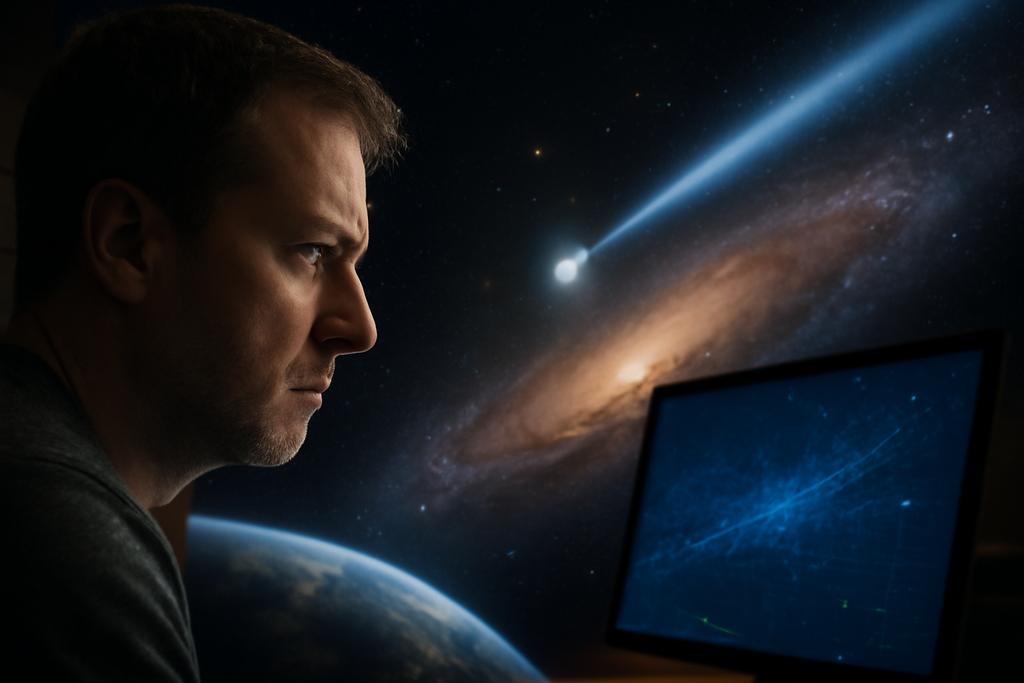For years, scientists have puzzled over the origins of high-energy neutrinos, ghostly subatomic particles that rain down on Earth from the cosmos. These elusive particles carry clues about some of the most violent events in the universe, but pinpointing their sources has proven remarkably difficult. Now, a new study from researchers at INAF – Osservatorio Astronomico di Brera suggests that a specific type of galaxy, known as a flat-spectrum radio quasar (FSRQ), might be a significant contributor to this cosmic neutrino shower.
The Ghostly Messengers
Neutrinos are famously difficult to detect. They barely interact with matter, passing through planets and stars as if they weren’t there. But their very elusiveness makes them uniquely valuable: they offer a direct, unfiltered view of their origins, unlike light, which can be scattered, absorbed, or otherwise altered on its journey to Earth. Detecting these particles requires massive, specialized detectors like IceCube, a cubic-kilometer array of sensors buried deep in the Antarctic ice. It patiently waits for those rare interactions, allowing scientists to reconstruct the direction of the arriving neutrino.
While IceCube has recorded thousands of high-energy neutrino events, assigning them to their sources has been an ongoing challenge. The large uncertainties in their trajectories make many associations tenuous at best. Even when a likely candidate appears, it’s difficult to rule out chance coincidence.
Active Galactic Nuclei and the Search for Sources
One of the prime suspects in the neutrino mystery has been a class of galaxies called Active Galactic Nuclei (AGN). These galaxies harbor supermassive black holes at their centers, gobbling up matter at an astonishing rate. This process creates an incredibly energetic environment that can accelerate particles to near the speed of light, potentially generating a torrent of high-energy neutrinos and other forms of radiation.
AGN come in various forms. Some are “radio-quiet,” meaning they don’t emit significant amounts of radio waves. Others are radio-loud, showcasing intense radio emissions powered by powerful jets erupting from the black hole’s vicinity. Within the radio-loud category, flat-spectrum radio quasars (FSRQs) are particularly interesting. These galaxies, characterized by their strong emission lines and a flat radio spectrum, have been considered promising candidates for neutrino production due to their powerful jets, which are often pointed almost directly at us, magnifying their apparent brightness through a phenomenon known as relativistic beaming.
A Statistical Deep Dive
In their study, Alberto Moretti and Alessandro Caccianiga analyzed data from the IceCube Event Catalog (IceCat-1) and a large catalog of quasars from the Sloan Digital Sky Survey (SDSS). They compared the locations of IceCube’s high-energy neutrino events with those of radio-quiet quasars and FSRQs, using the Cosmic Lens All Sky Survey (CLASS) to distinguish between them based on their radio emission. Their analysis, focusing on the northern sky where data coverage is consistent, revealed a subtle but intriguing pattern.
While the associations between neutrino events and radio-quiet quasars appeared random, the FSRQs showed a statistically significant correlation with the neutrino positions. This wasn’t just a simple headcount; the researchers used Monte Carlo simulations—essentially, a series of randomized tests—to determine the likelihood of the observed correlation occurring by chance. This rigorous approach showed that the correlation between FSRQs and neutrinos was a real phenomenon, not a fluke.
High-Declination Hotspot
Further analysis revealed a remarkable geographic pattern. The statistical significance of the correlation was dramatically higher when they limited their analysis to neutrinos detected at higher declinations (further from the celestial equator). This hinted that the positional accuracy of IceCube’s measurements might vary across the sky, potentially improving at higher declinations. While not fully understood, this could be a consequence of the telescope’s geometry and response characteristics. It’s a factor to account for in further analysis and suggests potential improvements for the detectors.
Jets vs. Accretion Disks: The Origin Story
This research carries a compelling implication. The lack of correlation between neutrinos and radio-quiet quasars suggests the neutrino production mechanism is tied to the presence of relativistic jets, rather than the accretion disk surrounding the black hole. While some recent studies have proposed accretion-related processes for neutrino production in certain AGN, the current findings strongly support the longstanding hypothesis that the powerful jets of FSRQs play a major role in generating these elusive particles.
The Big Picture
Moretti and Caccianiga’s work offers a crucial step in resolving a longstanding question in astrophysics. It suggests that a large fraction—potentially over 60%—of high-energy neutrinos detected by IceCube could originate from FSRQs. While this high estimate seems to challenge other studies, the researchers argue that existing analyses might underestimate the contribution of FSRQs due to observational biases and assumptions about neutrino production mechanisms.
Their findings provide strong support for the idea that FSRQs are major neutrino factories in the universe. This discovery paves the way for more focused studies, which might explore the specific mechanisms of neutrino production within these jets, and refine our understanding of the most powerful phenomena in the cosmos.










